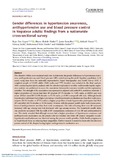Gender differences in hypertension awareness, antihypertensive use and blood pressure control in Nepalese adults: Findings from a nationwide cross-sectional survey
Date
2019-08-30Publisher
Cambridge University PressAuthor
Gupta, Rajat DasHaider, Shams Shabab
Sutradhar, Ipsita
Hasan, Mehedi
Joshi, Hemraj
Haider, Mohammad Rifat
Sarker, Malabika
Metadata
Show full item recordCitation
Das Gupta, R., Shabab Haider, S., Sutradhar, I., Hasan, M., Joshi, H., Rifat Haider, M., & Sarker, M. (2020). Gender differences in hypertension awareness, antihypertensive use and blood pressure control in Nepalese adults: Findings from a nationwide cross-sectional survey. Journal of Biosocial Science, 52(3), 412-438. doi:10.1017/S0021932019000531Abstract
The objective of this cross-sectional study was to determine the gender differences in hypertension awareness, antihypertensive use and blood pressure (BP) control among the adult Nepalese population (≥18
years) using data from the nationally representative Nepal Demographic and Health Survey 2016. A
weighted sample of 13,393 adults (5620 males and 7773 females) was included in the final analysis.
After conducting descriptive analyses with the selective explanatory variable, multivariable logistic regression analysis was performed to assess the association between the outcome variable and the explanatory
variables. The strength of the association was expressed in adjusted odds with 95% confidence intervals. A
higher proportion of women had their BP checked (87.7% females vs 73.0% males, p<0.001) and were
aware of their raised BP (43.9% females vs 37.1% males, p<0.001) compared with men. Although female
hypertensive individuals had a higher prevalence of antihypertensive medication use than their male counterparts (50.1% females vs 47.5% males), a higher proportion of male hypertensive participants had their
BP controlled (49.2% females vs 53.5% males). Women with the poorest wealth index had a lower prevalence of antihypertensive use than their male counterparts. The odds of having their own BP measured
increased with age among men but decreased with age among women. The household wealth index
was positively associated with the odds of BP measurement, awareness of own BP and antihypertensive
use. This study revealed that although women had a higher prevalence of hypertension awareness and
antihypertensive medication use, the practice did not translate into better BP control. Inequality in antihypertensive medication use was observed among the poorest wealth quintiles. Public health programmes
in Nepal should focus on reducing these inequalities. Further research is needed to learn why females have
poorer control of BP, despite having higher antihypertensive medication use.

